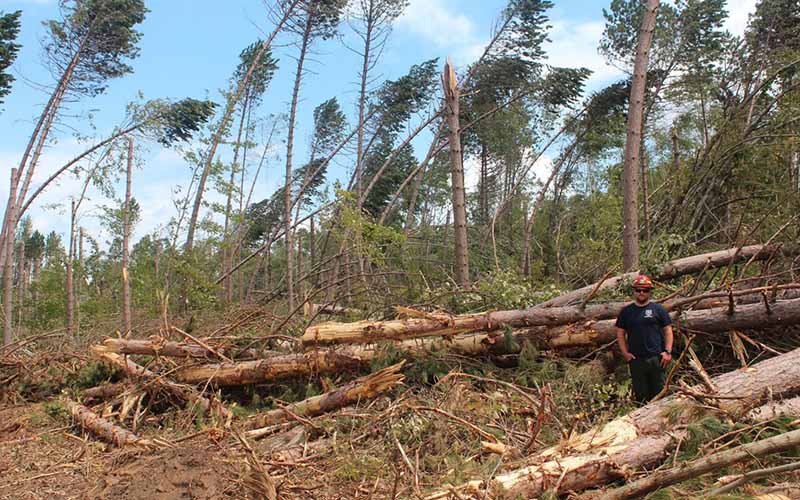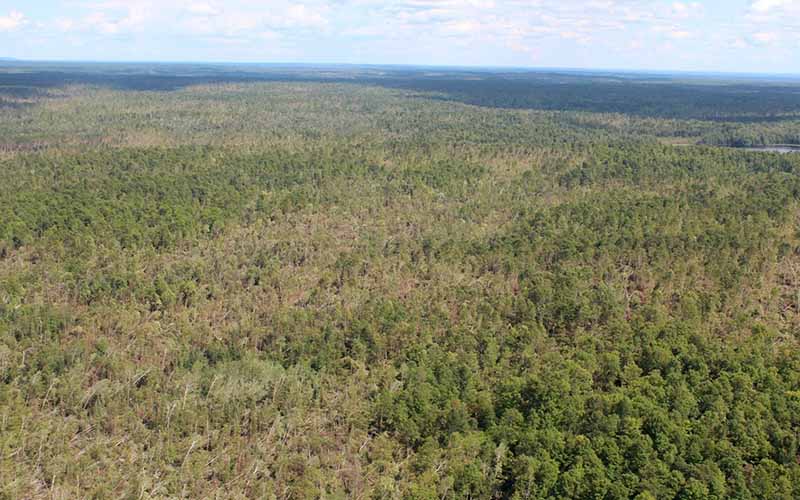Read this in Spanish / lee esto en español
John Lampereur is the district silviculturist for the Chequamegon-Nicolet National Forest.
Who are you/what is your role?
I am the district silviculturist on the southeastern most district of the Chequamegon-Nicolet National Forest. I was gone the night of the storm but I returned six days later and helped deal with the aftermath.
What led you to take action and what actions did you take?
There was widespread devastation in the forest and surrounding community after the derecho in 2019. We had a tornado in 2007 and that was a big deal at the time; it impacted 10,500 acres of national forest lands. The 2019 derecho impacted 130,000 acres of national forest lands. There were varying levels of damage, but about 63,000 acres of the forest had greater than 25 percent damage.
While the storm was devastating for people, property, and potentially, plants and animals, it had some long-term beneficial conservation impacts. The main thing we learned was that you need to have your emergency response plan ready and everyone needs to be prepared for major storms.

First, we had to restore transportation and infrastructure. We worked with local and state government to reestablish transportation. The process of opening forest and county roads took months. Some areas were without electricity for up to a week after the storm. There were thousands of trees down, across roads, and on homes. Initially the we just worked our way into the hard-to-reach areas like natural forest campgrounds where people were blocked and couldn’t get out.
We can’t really quantify how different species were impacted by the storm. A lot of these areas are still inaccessible and the data and monitoring just aren’t there. For example, we know that red shouldered hawk nests were impacted by downed trees. But how many? We don’t know yet.
Once the roads were open, we turned the focus to recovery. We have communities and individual homes in the forest here and having that many trees down is a huge wildfire fuel risk. We have been removing those fuels through salvage sales and other treatments to remove trees near homes and other property in the forest. We are still in this process.
We have sold 258 million board feet of timber in the two years since the storm, which is the same amount we would sell in a decade normally. We have sold the equivalent of 51,300 loaded logging trucks, seventy-five feet long, which would reach from Lakewood, Wisconsin, to Nashville, Tennessee. We want to get as much of the wood to market as we can. So, from an economic standpoint, the derecho was briefly beneficial.
How are you restoring the forest?
The storm took out large parts of the forest without completely devastating the canopy. This is allowing mid-shade tolerant species to colonize those openings, including oak, hickory, yellow birch, paper birch. Those species benefit from the higher light conditions.
In the long term, the mix that comes back will be more species-diverse than the one that was destroyed. Having more species diversity in the stands is a positive thing, especially considering climate change resilience. We are going with natural regeneration as much as possible. In places where we are planting, we are looking for seed sources from the south and east to accommodate future climate projections.

Any coordination with the tribes for restoration?
In a broad sense, tribal coordination is always a concern for the United States Forest Service in terms of protecting treaty rights. Those types of issues are more a matter of general coordination than in responding to a storm like this. However, one of the shade-intolerant species that will benefit is paper birch, which is an important tree for the local tribes.
What has been the impact on the streams in the forest?
The impact has been mainly positive. The landscape up here is a result of widespread forest exploitation in which essentially all of the forest was cut over. Streams had to be “improved” to get the logs to market. This was done by widening rivers, dynamiting rocks and removing debris. The river channels were straightened to float logs downstream easier. People did a lot of damage to the streams.
Removing the large, woody debris was harmful because debris creates complex habitat for fish. Fisheries biologists actually say the storm’s impact of increased debris and downed trees in the rivers up north was beneficial. It returned the rivers to a more natural state. The debris creates more complex habitat and cools the water. The downed logs create meandering in the streams and narrower and deeper channels. All this makes for better fish habitat.
What would you want other forest managers to know in the face of these events?
Get your emergency response plan in order so you can respond as quickly as possible. Plan for who has to be involved in the response and get the community involved in the issues and opportunities after a storm. Having a plan in place helps establish chains of response, and approvals, especially for state and federal agencies. You will also need satellite imagery or aerial photography immediately after the storm. This helps determine the lay of the land for deciding where resources need to go first.
You need to have established communication channels with your neighbors prior to an emergency, people like county emergency management. Don’t be caught off guard in responding. It’s all a community-building exercise.
Do you have hope for the future?
I have hope for the future because Mother Nature is far more resilient than we give her credit for. Whether a storm like this was caused by a changing climate or not, it has created the conditions for a more resilient landscape.
The views and opinions expressed in this interview are those of the authors and do not represent official policy or position of the University of Wisconsin-Madison or the Wisconsin Initiative on Climate Change Impacts.
For More Information
John Lampereur
District Silviculturist
Forest Service Lakewood/Laona RD
Chequamegon-Nicolet National Forest
15085 State Road 32
Lakewood, WI 54138
(715) 276-6333, ext. 4235
john.lampereur@usda.gov